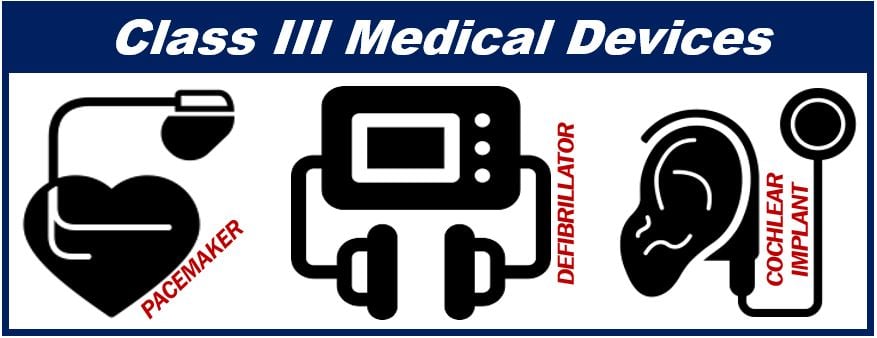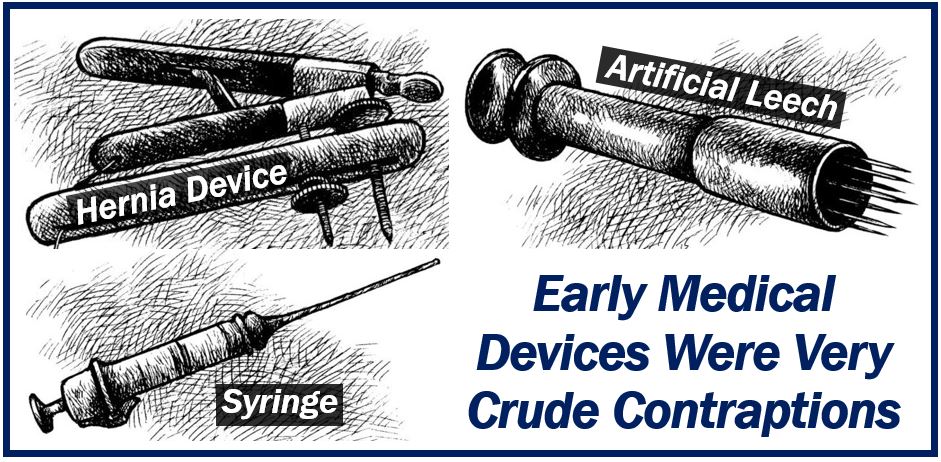Medical Devices are contrivances, devices, apparatus, machines, or pieces of equipment that have been created for medical purposes. The term also includes some reagents, software, and computers used in human or animal medicine.
Such devices are integral to modern healthcare, offering innovative solutions for diagnosis, treatment, and rehabilitation.

Healthcare professionals use some medications in combination with medical devices, often to enable the administration (delivery) of drugs. For example, a syringe is a medical device. We use syringes to administer antibiotics and other drugs into the patient’s body transdermally, i.e., through the skin. We can write the word healthcare as one word or two – healthcare or health care.
The US Food & Drug Administration (FDA) says the following about the term:
“Medical devices range from simple tongue depressors and bedpans to complex programmable pacemakers, and closed loop artificial pancreas systems. Additionally, medical devices include in vitro diagnostic (IVD) products, such as reagents, test kits, and blood glucose meters”
“Certain radiation-emitting electronic products that have a medical use or make medical claims are also considered medical devices. Examples of these include diagnostic ultrasound products, x-ray machines and medical lasers.”
These devices benefit humans and animals by helping doctors, nurses, and other healthcare professionals treat patients, and helping them overcome illnesses. They also help patients live with their illnesses or conditions by improving their quality of life.
Definitions of medical devices vary
The definitions of medical devices vary worldwide because there are several regulatory bodies that oversee their marketing. Although the FDA (USA), MHRA (UK), EMA (EU) and other bodies regularly collaborate and discuss meanings, there are subtle differences in their definitions of some words.
Put simply, the appropriate or precise definition of a device depends on where it is used.
Wikipedia.com says the following regarding the definition of the term:
“Often a portion of the definition of a medical device is intended to differentiate between medical devices and drugs, as the regulatory requirements of the two are different. Definitions also often recognize In vitro diagnostics as a subclass of medical devices and establish accessories as medical devices.”
Authorization of medical devices
As we do with drugs, medical devices in most countries have to go through a series of review processes before they can enter the marketplace.
The US FDA says that there are three classes of devices in healthcare:
-
Class 1

We refer to these types as low-risk devices. For example, oxygen masks, hospital beds, wheelchairs, bandages, tongue depressors, and handheld surgical instruments are Class 1.
-
Class 2

These include, for example, absorbable sutures, blood transfusion kits, catheters, CT (computed tomography) scanners, blood pressure cuffs, pregnancy test kits, and infusion pumps for intravenous drugs. They are intermediate-risk devices.
-
Class 3

Deep brain simulators, defibrillators, cochlear implants, breast implants, high-frequency ventilators, implanted prosthetics, and pacemakers are some examples of Class 3 devices. They are high risk.
Medical devices have been around a long time

Various types of healthcare contraptions have existed for much of human history. The road to the modern and effective medicine that we benefit so much from today has been a very long one. Along the way, humans have created a variety of gadgets and tools – some of them were quite gruesome.
-
Artificial leeches
When live leeches were not available in the 1800s, health care professionals used a metal cylinder with wide blades which rotated and cut into the skin. A long tube was used to suction the patient’s blood out. Another device, the sacrificator, sliced into human skin, and created a vacuum using heat to suck out blood.
-
Hernia tool
In the 1850s, doctors invented a tool specifically for hernias. After repairing the tear that caused the hernia, they used to insert the tool to help seal the incision.
-
Syringes
Syringes were considerably larger than the ones we use today. In the 1500s, people used them to inject mercury into, for example, sailors with syphilis. The injection went into the man’s urethra (the tube in the penis through which urine passes). Mercury, a highly toxic substance, would invariably kill the patient before the syphilis did. In those days, people did not know that mercury was poisonous.
What is a device?
Devices are things that people created or adapted for a specific purpose. We typically think of mechanical or electronic gadgets or equipment when we hear the word. However, the term includes a much wider range things.
-
Gadget vs. device
Although the words gadget and device are often used with the same meaning, their usage is slightly different.
When we cannot remember the name of something, we refer to it as a gizmo or gadget. We tend to use the term device even when we know or remember its proper name.
Also, devices include small and large things, while gadgets are only small ones. I could not call a giant pump or MRI machine a gadget – they are devices (MRI = magnetic resonance imaging).
The innovative progression in medical device technology has significantly advanced patient care and diagnostic precision.
Medical Devices, terms and concepts
There are many terms in the English language related to medical devices and the sector. Let’s take a look at some such compound phrases, learn their meanings, and see how we use them in a sentence:
-
Medical Device Regulation
The standards and requirements that govern the safety and efficacy of medical devices.
Example: “The new medical device regulation ensures that all devices undergo rigorous testing before reaching the market.”
-
Medical Device Manufacturer
A company that specializes in creating and producing medical devices.
Example: “The medical device manufacturer released a new line of portable heart monitors this year.”
-
Medical Device Innovation
The process of designing and developing new medical devices, typically incorporating advanced technology.
Example: “Medical device innovation has led to the development of less invasive surgical instruments.”
- Medical Device Approval
The official authorization that a medical device is safe and effective for use.
Example: “After a lengthy study, the medical device approval was finally granted by the regulatory body.”
-
Medical Device Sales
The commercial activity involved in the selling and distribution of medical devices.
Example: “She works in medical device sales and often attends conferences to keep up with industry trends.”
-
Medical Device Market
The economic sector or industry related to the trading of medical devices.
Example: “Analysts predict significant growth in the medical device market over the next decade due to an aging population.”
Video – What are Medical Devices?
This educational video, from our sister channel on YouTube – Marketing Business Network, explains what ‘Medical Devices’ are using simple and easy-to-understand language and examples.
